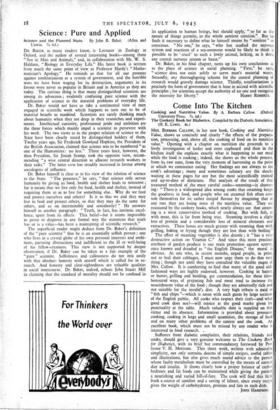Come Into The Kitchen
The Cookery Book for Diabetics. Compiled by the Diabetic Association. (H. K. Lewis. 4s.)
MRS. BARBARA CALLOW, in her new book, Cooking and Nutritive Value, shows us concisely and dearly " the effects of the prepara- tion, processing, and, above all, the cooking of food on its nutritive value." Opening with a chapter on nutrition she proceeds to a lively investigation of larder and store cupboard: and then in the kitchen itself she explains exactly what is happening to our meal while the food is cooking • indeed, she shows us the whole process, from its raw state, from the very moment of harvesting to the point at which we commence eating. Her findings are not always to the cook's advantage ; many and sometimes salutary . are the shocks waiting in these pages for any but the most scientifically trained and up-to-date of dieticians. Her analysis of the result of that treasured method of the most careful cooks—steaming—is shatter- ing : " There is a widespread idea among cooks that steaming keeps the goodness in food, and people who eat steamed fish often con- sole themselves for its rather insipid flavour by imagining that at any rate they are losing none of the nutritive value. They are reassured by the cookery books, which nearly always say that steam- ing is a most conservative method of cooking. But with fish, as with meat, this is far from being true. Steaming involves a slight loss of protein and a considerable loss of mineral elements and extractives. These losses are much greater with steaming than with grilling, baking or frying though they are less than with boiling."
The effect of steaming vegetables is also drastic ; it " has a very destructive action on Vitamin C." And since this most precious attribute of garden produce is our main protection against scurvy. once known and dreaded as " the English Disease," the moral is obvious. As one who, in recent months, urged people, in print, not to boil their cabbages, I must now urge them to do that very thing ' • though not until they have consulted the valuable pages of Mrs. Callow. It is comforting to find that many of the good old- fashioned ways are highly endorsed, however. Cooking in batter. or butter, grilling and broiling, get commendation, for these time- honoured ways of preparing fish and meat tend to increase the nourishment value of the food ; though they are admittedly rich and not suitable for the invalid's diet. A very high tribute is paid to " fish and chips "—which is eaten with such gusto by large sections of the English public. All cooks who respect their craft—and what good cook does not?—will rejoice at the good marks given for punctuality at the table. Much valuable data is supplied on this virtue and its absence. Information is provided about pressure- cooking, cooking in large and small quantities, the storage of food and on many other problems of the caterer and the cook. An excellent book, which must not be missed by any reader who is interested in food research. .
Sufferers from diabetic complaints, their relations, friends and cooks, should give' a very genuine welcome to The Cookery Book for Diabetics, with its brief but commendatory foreword by Pro- fessor V. H. Mottram. This short work, written with admirable simplicity, not only contains dozens of simple recipes, useful tables and illustrations, but also gives much sound advice to the person whose faulty metabolism must be controlled by the means of correct diet and insulin. It shows clearly how a prover balance of carbo- hydrates and fat foods can be maintained while giving the patient a nourishing and varied bill-of-fare. The cook will find this little book a source of comfort and a saving of labour, since every recipe gives the weight of carbohydrates, proteins and fats in each dish.
JOHN liAMESON.




























 Previous page
Previous page